The casting mold industry stands at the threshold of a decade-long expansion trajectory that promises to reshape metal forming technology and precision manufacturing solutions. The market's journey from USD 1,923.5 million in 2025 to USD 2,874.7 million by 2035 represents substantial growth, demonstrating the accelerating adoption of advanced alloy formulations and high-precision tooling technology across automotive manufacturing, aerospace component production, and electronics assembly sectors.
The first half of the decade (2025-2030) will witness the market climbing from USD 1,923.5 million to approximately USD 2,447.9 million, adding USD 524.4 million in value, which constitutes 55% of the total forecast growth period. This phase will be characterized by the rapid adoption of aluminum alloy mold systems, driven by increasing lightweighting requirements and the growing need for thermal management optimization solutions worldwide. Advanced surface treatment technologies and computer-aided mold design will become standard expectations rather than premium options.
The latter half (2030-2035) will witness sustained growth from USD 2,447.9 million to USD 2,874.7 million, representing an addition of USD 426.8 million or 45% of the decade's expansion. This period will be defined by mass market penetration of intelligent mold technologies, integration with comprehensive digital manufacturing platforms, and seamless compatibility with existing production infrastructure. The market trajectory signals fundamental shifts in how manufacturers approach component production and quality optimization, with participants positioned to benefit from sustained demand across multiple material types and application segments.
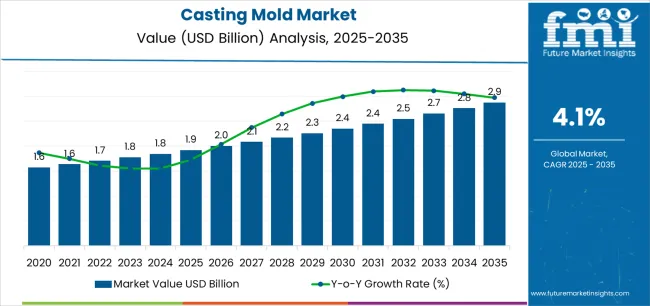
The casting mold market demonstrates distinct growth phases with varying market characteristics and competitive dynamics. Between 2025 and 2030, the market progresses through its lightweighting acceleration phase, expanding from USD 1,923.5 million to USD 2,447.9 million with steady annual increments averaging 4.1% growth. This period showcases the transition from traditional steel tooling to advanced aluminum alloy systems with enhanced thermal conductivity capabilities and integrated dimensional precision becoming mainstream features.
The 2025-2030 phase adds USD 524.4 million to market value, representing 55% of total decade expansion. Market maturation factors include standardization of alloy specifications, declining material costs for aluminum systems, and increasing manufacturer awareness of mold performance benefits reaching 98-99% dimensional accuracy in casting operations. Competitive landscape evolution during this period features established mold manufacturers like Qinhuangdao Hongtong Machinery and GF Casting Solutions expanding their alloy mold portfolios while specialty producers focus on advanced surface treatment development and enhanced thermal management capabilities.
From 2030 to 2035, market dynamics shift toward smart manufacturing integration and global production standardization, with growth continuing from USD 2,447.9 million to USD 2,874.7 million, adding USD 426.8 million or 45% of total expansion. This phase transition centers on sensor-embedded molds, integration with digital twin platforms, and deployment across diverse manufacturing scenarios, becoming standard rather than specialized tooling applications. The competitive environment matures with focus shifting from basic mold capability to comprehensive production optimization systems and integration with Industry 4.0 platforms.
| Metric | Value |
|---|---|
| Market Value (2025) | USD 1,923.5 million |
| Market Forecast (2035) | USD 2,874.7 million |
| Growth Rate | 4.1% CAGR |
| Leading Material Type | Aluminum Alloy Mold |
| Primary Application | Automobile Segment |
The market demonstrates strong fundamentals with aluminum alloy molds capturing a dominant share through advanced thermal properties and weight reduction capabilities. Automotive applications drive primary demand, supported by increasing vehicle electrification requirements and lightweighting technology adoption needs. Geographic expansion remains concentrated in developed markets with established manufacturing infrastructure, while emerging economies show accelerating adoption rates driven by industrial development and rising precision casting standards.
Market expansion rests on three fundamental shifts driving adoption across manufacturing and industrial production sectors. First, automotive lightweighting mandates create compelling operational demand through casting molds that provide precise component production without material waste, enabling manufacturers to meet efficiency standards while maintaining structural integrity and reducing vehicle weight. Second, production efficiency requirements accelerate as manufacturing facilities worldwide seek durable tooling systems that maximize output while maintaining dimensional accuracy during high-volume casting and metal forming operations.
Third, component complexity advancement drives adoption from aerospace manufacturers and electronics producers requiring intricate geometries that enhance product performance while maintaining tight tolerances during precision casting operations. However, growth faces headwinds from raw material cost volatility that varies across metal suppliers regarding aluminum and copper alloy sourcing, which may limit adoption in price-sensitive manufacturing markets. Technical challenges also persist regarding thermal fatigue resistance and mold lifespan variations that may reduce production efficiency in high-temperature casting applications, which affect operational costs and manufacturing profitability.
The casting mold market represents a fundamental manufacturing technology opportunity driven by expanding industrial production, automotive electrification advancement, and the need for superior dimensional precision in metal component manufacturing. As production facilities worldwide seek to achieve 98-99% dimensional accuracy, extend mold lifespan, and integrate advanced tooling systems with digital manufacturing platforms, casting molds are evolving from basic production tools to sophisticated manufacturing enablement solutions that ensure quality outcomes and operational efficiency.
The convergence of lightweighting requirements growth, precision manufacturing advancement, and material technology development creates sustained demand drivers across multiple industrial segments. The market's growth trajectory from USD 1,923.5 million in 2025 to USD 2,874.7 million by 2035 at a 4.1% CAGR reflects fundamental shifts in manufacturing requirements and production optimization.
Geographic expansion opportunities are particularly pronounced in Asia-Pacific markets, where China (5.5% CAGR) and India (5.1% CAGR) lead through aggressive manufacturing expansion and automotive production infrastructure development. The dominance of aluminum alloy mold systems (58.0% market share) and automobile applications (52.0% share) provides clear strategic focus areas, while emerging advanced coating technologies and additive manufacturing integration open new revenue streams across diverse casting markets.
Strengthening the dominant aluminum alloy segment (58.0% market share) through enhanced thermal conductivity, superior dimensional stability characteristics, weight optimization compatibility, and seamless integration with modern casting infrastructure. This pathway focuses on optimizing alloy composition, improving surface hardness performance, extending operational lifespan to 50,000-100,000 cycles, and developing specialized formulations for high-pressure die casting applications. Market leadership consolidation through advanced metallurgy, comprehensive heat treatment protocols, and thermal management integration enables premium positioning while defending competitive advantages against copper alloy alternatives. Expected revenue pool: USD 135-175 million
Strategic expansion within copper alloy technology (28.0% market share) through enhanced thermal fatigue resistance, superior heat dissipation capabilities, and comprehensive durability optimization for demanding casting environments. This pathway addresses extreme temperature requirements, extended cycle operations, and specialized casting processes with advanced copper-beryllium alloys for high-performance standards. Premium positioning reflects metallurgical excellence, thermal engineering expertise, and durability capabilities while enabling access to aerospace casting programs and high-precision component manufacturing networks. Expected revenue pool: USD 65-85 million
Expansion within the dominant automobile segment (52.0% market share) through specialized powertrain component molds, electric vehicle battery housing tooling, and comprehensive production support for automotive foundries. This pathway encompasses high-volume production capability, dimensional precision optimization, rapid changeover systems, and compatibility with diverse casting scenarios. Premium positioning reflects superior quality consistency, automotive specification compliance, and comprehensive technical support that enables modern vehicle production while facilitating integration with just-in-time manufacturing and quality management systems. Expected revenue pool: USD 152-198 million
Development within aerospace applications (28.0% share) addressing ultra-precision requirements, enhanced material purity standards, and specialized certification protocols for aviation component casting. This pathway encompasses non-destructive testing integration, aerospace material compatibility, advanced surface finish specifications, and stringent quality documentation for critical applications. Technology differentiation through proprietary alloy compositions, precision machining capabilities, and comprehensive traceability enables premium pricing while expanding addressable market opportunities across commercial aviation and defense manufacturing segments. Expected revenue pool: USD 82-106 million
Rapid manufacturing development across China (5.5% CAGR) and India (5.1% CAGR) creates substantial expansion opportunities through local foundry partnerships, automotive supplier integration, and comprehensive regional manufacturing development. Growing automotive production volumes, industrial equipment manufacturing, and precision casting adoption drive sustained demand for tooling systems. Localization strategies reduce logistics costs, enable rapid technical support, and position companies advantageously for OEM supplier programs while accessing growing domestic markets requiring precision casting solutions. Expected revenue pool: USD 125-162 million
Integration of sensor technology and IoT connectivity for real-time temperature monitoring, predictive maintenance analytics, and comprehensive production optimization through intelligent tooling systems. This pathway encompasses embedded sensor networks, digital twin integration, automated quality verification, and extensive manufacturing intelligence for foundry efficiency enhancement. Premium positioning through digitalization capabilities, predictive optimization, and comprehensive analytics creates opportunities for service-based revenue models through technology-enabled casting advancement. Expected revenue pool: USD 58-75 million
Primary Classification: The market segments by material type into Aluminum Alloy Mold, Copper Alloy Mold, and Others categories, representing the evolution from traditional steel tooling to advanced specialty alloy systems for comprehensive casting optimization.
Secondary Classification: Application segmentation divides the market into Automobile, Aerospace, Electronics and Electrical Appliances, and Others sectors, reflecting distinct requirements for production volumes, dimensional precision, and material specifications.
Regional Classification: Geographic distribution covers Asia Pacific, Europe, North America, Latin America, and the Middle East & Africa, with developed markets leading adoption while emerging economies show accelerating growth patterns driven by manufacturing expansion programs.
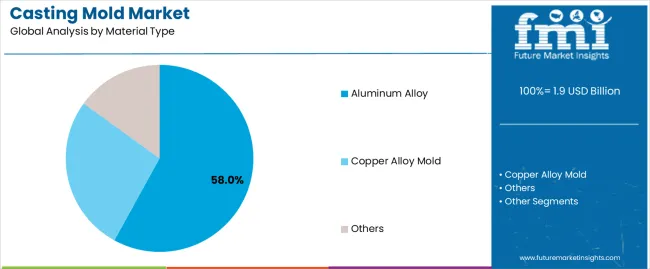
Market Position: Aluminum alloy molds command the leading position in the casting mold market with approximately 58.0% market share through advanced thermal management features, including superior heat conductivity, excellent dimensional stability capability, and weight optimization that enable foundries to achieve optimal casting quality across diverse manufacturing environments.
Value Drivers: The segment benefits from automotive foundry preference for lightweight tooling systems that provide rapid thermal cycling, reduced handling complexity, and extended operational stability without requiring significant infrastructure modifications. Advanced alloy features enable high-pressure die casting compatibility, thermal fatigue resistance, and integration with existing foundry equipment, where thermal performance and operational efficiency represent critical manufacturing requirements.
Competitive Advantages: Aluminum alloy systems differentiate through proven thermal conductivity, consistent dimensional characteristics, and integration with modern casting processes that enhance production effectiveness while maintaining optimal component quality suitable for diverse automotive applications.
Key market characteristics:
Copper alloy molds maintain a significant 28.0% market share in the casting mold market due to their exceptional thermal conductivity and extreme temperature resistance properties. These systems appeal to foundries requiring superior heat dissipation with extended operational durability for high-performance casting applications. Market presence is driven by aerospace component manufacturing, emphasizing dimensional precision and material consistency through advanced copper-beryllium technology systems.
Alternative materials hold approximately 14.0% market share, focusing on steel-based tooling and composite mold systems. These formulations serve specialized casting requirements and cost-sensitive applications requiring conventional tooling approaches.
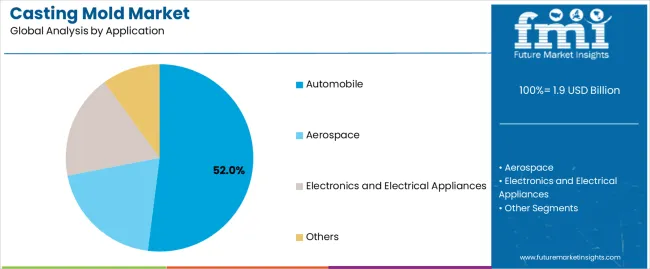
Market Context: Automobile applications dominate the casting mold market with approximately 52.0% market share due to critical lightweighting requirements and increasing focus on production efficiency optimization, component quality management, and high-volume manufacturing applications that minimize dimensional variation while maintaining automotive industry standards.
Appeal Factors: Automotive engineers prioritize dimensional accuracy, production throughput, and integration with automated foundry infrastructure that enables coordinated manufacturing across multiple component lines. The segment benefits from substantial automotive investment and electric vehicle development programs that emphasize the acquisition of precision tooling systems for powertrain and structural component applications.
Growth Drivers: Vehicle electrification programs incorporate aluminum casting as standard requirements for battery housing and motor components, while lightweighting mandates increase the need for advanced mold capabilities that comply with automotive specifications and minimize component weight.
Market Challenges: Varying component geometries and alloy composition requirements may limit mold standardization across different vehicle platforms or manufacturer specifications.
Application dynamics include:
Aerospace component manufacturing captures approximately 28.0% market share through precision casting requirements in turbine components, structural aerospace parts, and specialized aviation hardware production. These applications demand ultra-precision molds capable of operating in controlled environments while delivering exceptional dimensional consistency and material integrity characteristics.
Electronics manufacturing accounts for approximately 14.0% market share, including consumer electronics housings, electrical connector production, and heat sink component applications requiring precise dimensions for functional performance and thermal management optimization.
Growth Accelerators: Automotive lightweighting advancement drives primary adoption as casting molds provide precision component production capabilities that enable manufacturers to meet weight reduction objectives without compromising structural integrity, supporting fuel efficiency and sustainability missions that require aluminum component integration. Production efficiency requirements accelerate market expansion as foundries seek durable tooling that maximizes output while maintaining dimensional accuracy during high-volume casting and component manufacturing scenarios. Advanced manufacturing investment increases worldwide, creating sustained demand for precision tooling systems that complement traditional foundry methods and provide operational flexibility in complex production environments.
Growth Inhibitors: Raw material cost volatility varies across metal suppliers regarding aluminum and copper alloy pricing fluctuations, which may limit operational flexibility and market penetration in regions with commodity price sensitivity or cost-constrained foundry operations. Thermal fatigue challenges persist regarding high-temperature cycling effects and surface degradation that may reduce mold lifespan in intensive production environments, affecting tooling costs and manufacturing economics. Market fragmentation across multiple casting processes and proprietary specifications creates compatibility concerns between different foundry requirements and standardized mold capabilities.
Market Evolution Patterns: Adoption accelerates in automotive manufacturing and aerospace component sectors where precision requirements justify tooling investments, with geographic concentration in developed markets transitioning toward mainstream adoption in emerging economies driven by manufacturing infrastructure expansion and automotive production growth. Technology development focuses on enhanced surface treatments, improved thermal management designs, and integration with digital monitoring systems that optimize mold performance and production quality. The market could face disruption if additive manufacturing technologies significantly advance metal component production or if alternative forming methods change the deployment of traditional casting processes in manufacturing applications.
The casting mold market demonstrates varied regional dynamics with Growth Leaders including China (5.5% CAGR) and India (5.1% CAGR) driving expansion through manufacturing infrastructure development and automotive production network growth. Steady Performers encompass Germany (4.7% CAGR), Brazil (4.3% CAGR), and United States (3.9% CAGR), benefiting from established foundry industries and advanced casting technology adoption. Mature Markets feature United Kingdom (3.5% CAGR) and Japan (3.1% CAGR), where specialty aerospace applications and precision-focused manufacturing support consistent growth patterns.
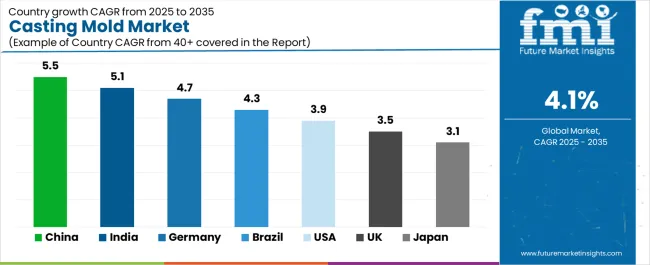
| Country | CAGR (2025-2035) |
|---|---|
| China | 5.5% |
| India | 5.1% |
| Germany | 4.7% |
| Brazil | 4.3% |
| United States | 3.9% |
| United Kingdom | 3.5% |
| Japan | 3.1% |
Regional synthesis reveals Asia-Pacific markets leading adoption through automotive manufacturing expansion and foundry infrastructure development, while European countries maintain steady growth supported by precision engineering advancement and casting technology standardization requirements. North American markets show moderate growth driven by aerospace manufacturing applications and automotive lightweighting integration trends.
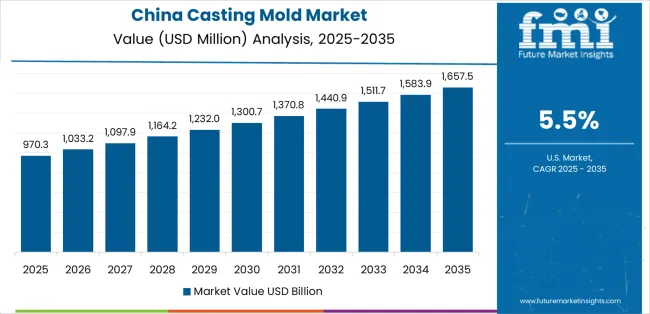
China establishes high-growth leadership through rapid automotive manufacturing expansion and comprehensive foundry infrastructure development, integrating casting molds as standard production tools in automotive component and industrial equipment installations. The country's 5.5% CAGR reflects industrialization initiatives promoting manufacturing capability and production quality standards that mandate the use of precision tooling systems in foundry and casting operations. Growth concentrates in major manufacturing centers, including Guangzhou, Shanghai, and Chongqing, where automotive production showcases integrated casting systems that appeal to OEM suppliers seeking advanced tooling capabilities and production efficiency solutions.
Chinese mold manufacturers are developing cost-effective tooling solutions that combine competitive pricing advantages with improved material specifications, including enhanced aluminum alloys and advanced surface treatments. Distribution channels through automotive supplier networks and foundry equipment distributors expand market access, while technical training programs for foundry modernization support adoption across diverse automotive component and industrial casting segments.
Strategic Market Indicators:
In Pune, Chennai, and manufacturing centers, automotive foundries and component suppliers are implementing casting molds as standard production tools for component manufacturing and quality optimization, driven by increasing automotive production and industrial development programs that emphasize the importance of precision casting capabilities. The market holds a 5.1% CAGR, supported by expanding automotive manufacturing base and foundry modernization advancement initiatives that promote precision tooling systems for automotive supplier and industrial component applications. Indian foundries are adopting aluminum alloy molds that provide cost-effectiveness and thermal performance, particularly appealing in automotive hubs where production efficiency and component quality represent critical operational requirements.
Market expansion benefits from growing automotive supplier capabilities and international technology partnerships that enable domestic production of precision tooling for foundry and casting applications. Technology adoption follows patterns established in automotive manufacturing, where quality standards and production efficiency drive equipment investments and capability development.
Market Intelligence Brief:
Germany's manufacturing market demonstrates robust foundry capability with documented casting effectiveness in automotive component production and industrial equipment manufacturing through established quality infrastructure. The country leverages engineering precision and manufacturing expertise to maintain a 4.7% CAGR. Foundry facilities, including Stuttgart, Munich, and Wolfsburg regions, showcase mold implementations where advanced tooling systems integrate with comprehensive quality management programs and production control systems to optimize manufacturing effectiveness.
German foundries prioritize dimensional accuracy and operational reliability in mold selection, creating demand for advanced systems with comprehensive quality features, including precision machining and thermal optimization capabilities. The market benefits from established automotive manufacturing infrastructure and willingness to invest in quality-enhancing tooling technologies that provide production benefits and compliance with automotive quality standards.
Market Intelligence Brief:
Brazil's market expansion benefits from growing automotive production capacity, including manufacturing development in São Paulo and Curitiba, foundry infrastructure advancement, and automotive industry programs that increasingly require precision casting for component applications. The country maintains a 4.3% CAGR, driven by automotive manufacturing growth and increasing recognition of casting quality benefits, including dimensional consistency and production efficiency capabilities.
Market dynamics focus on cost-effective mold solutions that balance precision performance with affordability considerations important to Brazilian foundries. Growing automotive production creates sustained demand for casting molds in manufacturing infrastructure and automotive supplier development projects.
Strategic Market Considerations:
The USA market emphasizes advanced casting technologies, including simulation-driven mold design and integration with comprehensive digital manufacturing platforms that handle production optimization, quality prediction, and process control applications through unified factory systems. The country holds a 3.9% CAGR, driven by aerospace manufacturing advancement and automotive lightweighting initiatives that support casting technology integration. American foundries prioritize operational efficiency with mold systems delivering consistent quality through advanced thermal management and precision machining capabilities.
Technology deployment channels include automotive OEM suppliers, aerospace component manufacturers, and foundry equipment distributors that support professional applications for high-precision casting requirements. Digital manufacturing platform integration capabilities with established production systems expand market appeal across diverse operational requirements seeking quality and efficiency benefits.
Performance Metrics:
In Birmingham, Sheffield, and manufacturing centers, British foundries and aerospace component manufacturers are implementing advanced casting molds to enhance production capabilities and support modern manufacturing operations that align with aerospace standards and quality requirements. The UK market holds a 3.5% CAGR, driven by aerospace manufacturing specialization and production efficiency optimization that emphasize precision tooling for aerospace component and specialized casting applications. British foundries are prioritizing mold systems that provide dimensional consistency while maintaining operational reliability, particularly important in aerospace operations and precision component manufacturing facilities.
Market expansion benefits from aerospace manufacturing culture that mandates precision tooling capabilities in foundry specifications, creating sustained demand across the UK's aerospace and specialty manufacturing sectors, where dimensional accuracy and material traceability represent critical requirements. The quality framework supports precision casting adoption through aerospace standards and manufacturing requirements that promote validated tooling systems aligned with AS9100 specifications.
Strategic Market Indicators:
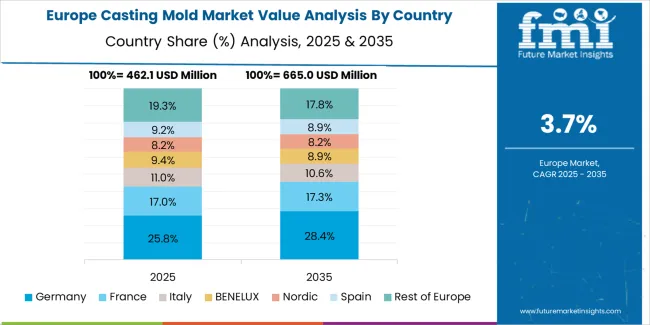
The European casting mold market is projected to grow steadily over the forecast period. Germany is expected to maintain its leadership position with a 32.4% market share in 2025, supported by its advanced automotive manufacturing infrastructure and major foundry networks across Stuttgart, Munich, and Wolfsburg regions.
France follows with a 26.8% share in 2025, driven by comprehensive automotive production programs and aerospace manufacturing development initiatives. Spain holds an 18.6% share in 2025 through automotive component advancement and foundry infrastructure modernization. The United Kingdom commands a 14.2% share, while Italy accounts for 8.0% in 2025. The Rest of Europe region is anticipated to maintain momentum attributed to increasing precision casting adoption in Nordic countries and emerging Eastern European automotive suppliers implementing manufacturing technology programs.
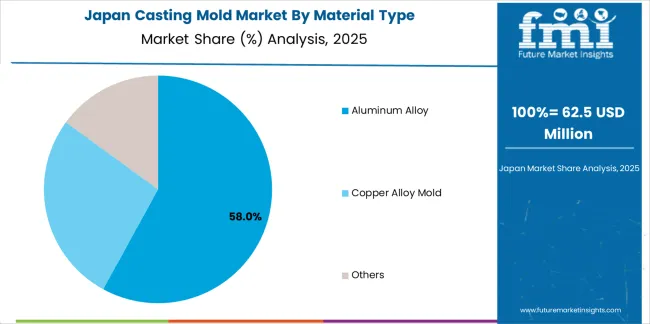
In Japan, the casting mold market prioritizes aluminum alloy systems, which capture the dominant share of automotive foundry and precision manufacturing installations due to their advanced features, including superior thermal management and seamless integration with existing production infrastructure. Japanese manufacturers emphasize quality, dimensional precision, and long-term operational reliability, creating demand for aluminum alloy molds that provide consistent casting capabilities and adaptive performance based on production requirements and component specifications. Other material types maintain secondary positions primarily in specialized aerospace applications and high-temperature casting installations where copper alloy molds meet operational requirements without compromising thermal performance.
Market Characteristics:
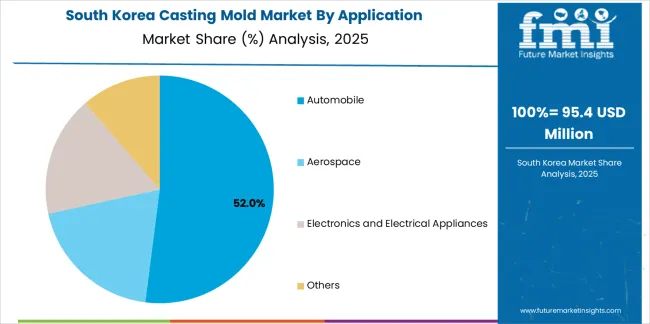
In South Korea, the market structure favors international casting mold manufacturers, including GF Casting Solutions and specialized tooling providers, which maintain dominant positions through comprehensive product portfolios and established automotive supplier networks supporting component manufacturing and precision casting installations. These providers offer integrated solutions combining precision tooling with professional technical services and ongoing engineering support that appeal to Korean foundries seeking reliable production systems. Local mold manufacturers and foundry equipment suppliers capture a moderate market share by providing localized technical support and competitive pricing for standard production installations, while domestic companies focus on specialized applications and cost-effective solutions tailored to Korean automotive manufacturing characteristics.
Channel Insights:
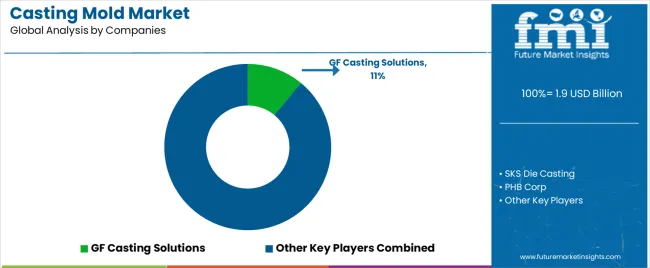
The casting mold market operates with moderate concentration, featuring approximately 30-35 meaningful participants, where leading companies control roughly 42-48% of the global market share through established foundry relationships and comprehensive tooling portfolios. GF Casting Solutions maintains a leading position with approximately 11.0% market share through extensive casting expertise and global automotive network operations. Competition emphasizes dimensional precision, thermal performance, and technical support rather than price-based rivalry.
Market Leaders encompass GF Casting Solutions, Qinhuangdao Hongtong Machinery, and Xuancheng Changtuo Metal Technology, which maintain competitive advantages through extensive metallurgical expertise, global automotive foundry networks, and comprehensive engineering capabilities that create customer loyalty and support premium pricing. These companies leverage decades of casting technology experience and ongoing material development investments to develop advanced mold systems with precision machining and thermal optimization features.
Technology Innovators include Ningbo Heli Mold Technology, Wuxi Feierkang Precision Casting Engineering, and RJCmold, which compete through specialized material focus and innovative thermal management designs that appeal to foundries seeking advanced casting capabilities and extended operational lifespan. These companies differentiate through rapid customization capabilities and specialized automotive application focus.
Regional Specialists feature companies like Dalian Hongsheng Machinery, Foshan Nanhai Benda Mold, and Sunrise Metal, which focus on specific geographic markets and specialized applications, including custom mold development and precision machining services. Market dynamics favor participants that combine reliable dimensional performance with comprehensive technical support, including thermal analysis services and production optimization capabilities. Competitive pressure intensifies as traditional tooling manufacturers expand into advanced alloy systems, while specialized foundry equipment companies challenge established players through digital monitoring integration and predictive maintenance solutions targeting modern automotive manufacturing segments.
| Item | Value |
|---|---|
| Quantitative Units (2025) | USD 1,923.5 million |
| Material Type | Aluminum Alloy Mold, Copper Alloy Mold, Others |
| Application | Automobile, Aerospace, Electronics and Electrical Appliances, Others |
| Regions Covered | Asia Pacific, Europe, North America, Latin America, Middle East & Africa |
| Countries Covered | China, India, Germany, Brazil, United States, United Kingdom, Japan, and 25+ additional countries |
| Key Companies Profiled | Qinhuangdao Hongtong Machinery, Xuancheng Changtuo Metal Technology, Ningbo Heli Mold Technology, Wuxi Feierkang Precision Casting Engineering, Dalian Hongsheng Machinery, GF Casting Solutions |
| Additional Attributes | Dollar sales by material type and application categories, regional adoption trends across Asia-Pacific, Europe, and North America, competitive landscape with mold manufacturers and foundry equipment suppliers, foundry preferences for dimensional accuracy and thermal performance, integration with digital manufacturing platforms and quality management systems, innovations in alloy formulations and surface treatment technologies, and development of technical services with enhanced thermal analysis support and production optimization capabilities. |
The global casting mold market is estimated to be valued at USD 1.9 billion in 2025.
The market size for the casting mold market is projected to reach USD 2.9 billion by 2035.
The casting mold market is expected to grow at a 4.1% CAGR between 2025 and 2035.
The key product types in casting mold market are aluminum alloy , copper alloy mold and others.
In terms of application, automobile segment to command 52.0% share in the casting mold market in 2025.






Full Research Suite comprises of:
Market outlook & trends analysis
Interviews & case studies
Strategic recommendations
Vendor profiles & capabilities analysis
5-year forecasts
8 regions and 60+ country-level data splits
Market segment data splits
12 months of continuous data updates
DELIVERED AS:
PDF EXCEL ONLINE
Casting Multi-stage Centrifugal Blower Market Size and Share Forecast Outlook 2025 to 2035
Podcasting Market Size and Share Forecast Outlook 2025 to 2035
Die Casting Services Market Analysis - Growth & Forecast 2025 to 2035
Grid Casting Machine Market Size and Share Forecast Outlook 2025 to 2035
Metal Casting Market Size and Share Forecast Outlook 2025 to 2035
Forged and Casting Component Market Size and Share Forecast Outlook 2025 to 2035
Investment Casting Market Size and Share Forecast Outlook 2025 to 2035
Automotive Casting Market Analysis - Size, Share, and Forecast Outlook 2025 to 2035
Weather Forecasting Services Market - Growth & Forecast through 2034
AI Demand Forecasting Software Market Size and Share Forecast Outlook 2025 to 2035
Iron and Steel Casting Market Size and Share Forecast Outlook 2025 to 2035
Automotive Die-casting Lubricants Market – Size, Share, and Forecast 2025 to 2035
Hot Chamber Die Casting Machine Market Growth - Trends & Forecast 2025 to 2035
Television Broadcasting Services Market Insights – Growth & Forecast 2023-2033
4K Satellite Broadcasting Market Size and Share Forecast Outlook 2025 to 2035
North America Iron Casting Market - Growth & Demand 2025 to 2035
Differential Pressure Casting Machine Market Forecast and Outlook 2025 to 2035
Ductile and Grey Iron Casting Products Market Size and Share Forecast Outlook 2025 to 2035
Orthopaedic Bone Cement and Casting Material Market Growth – Trends & Forecast 2025 to 2035
Metal Stampings, Forgings, and Castings Market Growth – Trends & Forecast 2025 to 2035

Thank you!
You will receive an email from our Business Development Manager. Please be sure to check your SPAM/JUNK folder too.
Chat With
MaRIA